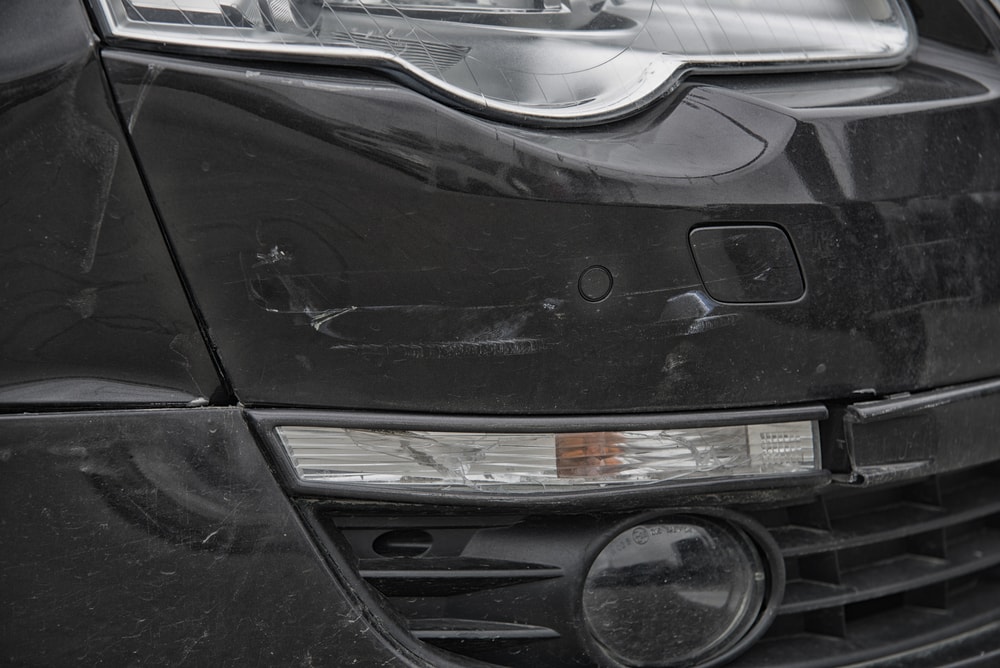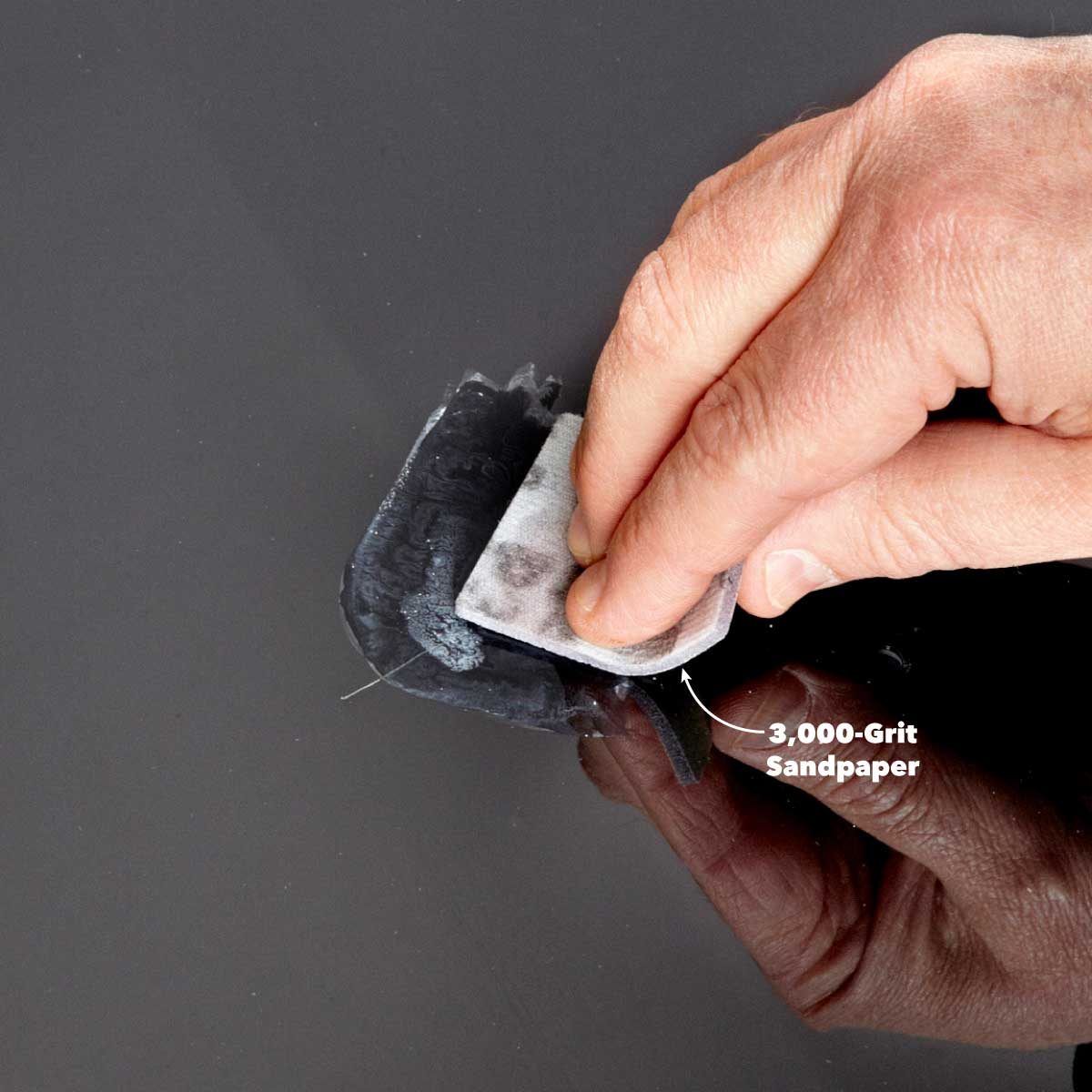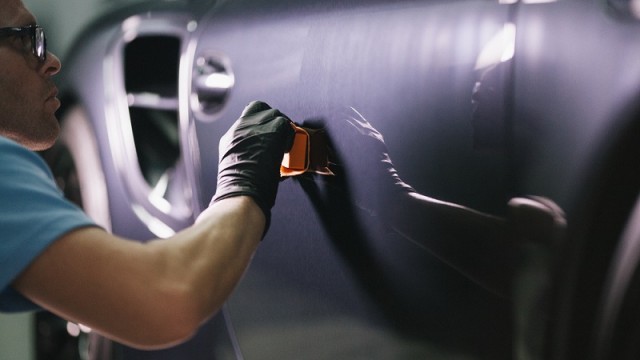To remove a surface-level scratch from your car, try using non-gel toothpaste. First, spread a thick layer of the toothpaste over the scratch with a cloth. Then, use a clean toothbrush to work the toothpaste into the scratch. When you've thoroughly brushed the area, rinse off the toothpaste, and the scratch should be gone. First, sand the scratched area with 2000-grit sandpaper until the surface of your car feels rough. Then, rinse off the area and wipe it dry with a cloth.
Next, spray the area you sanded with auto-body primer, and let it dry for 20 to 30 minutes. Once it's dry, spray the area with auto-body paint that matches the color of your car. If nothing else is working, try using a car scratch remover kit. After you're done cleaning and buffing the scratches areas, the next thing you need to do is wipe the surface with a microfiber cloth. Deep scratches, or primer scratches, extend down into the primer layer and often into the bare metal of your car. Unless you're an experienced do-it-yourselfer, these deep types of scratches are best fixed by a professional repair shop.
Below you'll find our top picks for combating paint defects, so read on and see which one is right for you and for some pro tips. Scratches in car paint can be caused by a variety of things. Car accidents, vandalism, poor parking, and other parking lot mishaps are all common causes for a scratch or 2 on your perfect paint job. While scratches do detract from the appearance of your car, paying a body shop for a new coat of paint or even a small touch-up can be costly. You can try buffing out surface scratches with toothpaste, using a scratch removal product for small scratches, or sanding and repainting the area if the scratch is deep.
You must use a high-quality and best black plastic trim restorer for cars to execute the color restoration process. Otherwise, many such products are available on the market that does not live up to the expectations of removing scratches from plastic car exterior. Keeping your car in tip-top shape on the outside is just as important as the inside. A professional car detailing typically includes polishing the paintwork to remove any scratches and swirl marks and buffing on a wax coat to protect the paint. Fortunately, you can use the Synchrony Car Care™ credit card for all your automotive needs, including professional detailing and repairing deep scratches.
Apply now Be sure to use a light hand and don't polish too hard, as this could damage the clear coat. So that you can easily manage all your car maintenance—whether it's routine oil changes or unexpected repair work. Conveniently manage your account online 24/7 with secure account access or download the mobile app.
Now that you know the step-by-step process to fix scratched plastic car exterior, you must know which plastic and trim restorer works best for the purpose. There are many car scratch trim restorers present on the market that you can consider buying for fixing the scratches. But if you are looking for a reliable and best black plastic trim restorer for your dear car, then here are some top-rated options that you can choose from. Rubbing Compounds If the paint transfer scuffs affected the deeper layers of the clear coat, then you might have a need for a rubbing compound.
This is more abrasive than your conventional scratch removers. Do take note, that such products often require an electric machine to apply the rubbing compound. Meguiar's Ultimate Compound – You can use any rubbing compound you like, just make sure it is clear coat safe.
I think that Meguiar's Ultimate Compound is the best car scratch remover currently on the market. It removes light-to-deep clear coat scratches, swirl marks, stains, and heavy oxidation in just a few minutes. It is formulated to level imperfections and leave a smooth finish. You can use it by hand of with a polishing machine. These products are usually one-step, single application formulas, that allow quick and easy paintwork finish improvement. These products can be used for localized repair to a single scratch or can be applied like a conventional wax for overall car finish restoration.
Minor scratches only affect the clear coat layer of a car's finish. These are the easiest types scratches to repair, as they can be rubbed or polished out without needing to be repainted. If you can't see any metal underneath the scratch, it's probably a clear coat scratch.
This is an excellent exterior black trim restorer for cars that have faded and scratched exterior surfaces. Are you looking for the best black plastic car trim restorer? Then you will be delighted with this top-rated car plastic scratch remover product. This very affordable and durable plastic trim restorer has all the qualities to effectively fix your car's scratches. Your search for the best black trim restorer for cars ends with this best-rated auto plastic trim restorer product!
You get all the desired qualities in this trim restorer that you need for fixing the scratches on your car's exterior surface. This awesome black trim and plastic restorer not only restores the scratches but is also effective in dealing with all types of dirt, wax residue, oxidation, etc. Alternatively, you can use toothpaste to buff out the scratches. Most kinds of toothpaste contain mild abrasives that help remove the damaged layer of clear coating on your vehicle. Not to mention, it will save you a trip to an automotive supply store. We recommend using a mildly abrasive whitening toothpaste to complete the job.
Use a nonabrasive microfiber or terry cloth to buff your vehicle. When you are done buffing the vehicle, wax the surface to create a polished finished look. If the above products didn't work, sand it with a fine wet/dry 1,500 grit sandpaper.
Soak sandpaper in cold water with few drops of dishwasher soap for about 10 minutes. Carefully sand down the mark without sanding through to the clear coat. After sanding, apply rubbing compound to get rid of sanding marks. Using soap and water is all it takes to remove paint transfer from a car bumper in these 5 simple steps. As a quick and easy way to remove stuck-on paint , use a magic eraser.
Scratch and swirl removers should be used to remove light scratches or surface blemishes, typically noticeable on the surface paint. Examples are the light marks from fingernails around door handles, light scuffs or when a finish loses its gloss. These products are safe cleaners for removing general road film or swirl marks from automatic car washes.
There is nothing worse than discovering a new scratch on your car's surface... Whether it's a light scratch or swirls, it can be easily solved without the need for expensive repairs at a body shop. Check out our article below for a simple guide on how to remove scratches from car surfaces with the use of a few Turtle Wax scratch remover products. What a great solution for minor paint repairs on your car.
After rubbing your car down with toothpaste, seeing as toothpaste is a fine sandpaper, is there a noticeable difference between the shine, or polish, of the treated spot? And, if there is a large area on your vehicle that needs treated, taking it a professional body shop may be your best option for fixing your paint job. When you are done washing off the extra dirt from the scratch point of your car, you must buff out the scratches using 800 grit sandpaper. This will smoothen the scratch surface, which shall make your scratch fixing process easier. If you want to remove scratches from plastic trim or plastic bumper of your car, then this step is a must as it helps a lot in the fixing process.
If the scratches are light enough, they can usually be corrected with car scratch remover products. Deep scratches and scuffs that go past the clear coat, on the other hand, are better removed via a longer process. If you follow these instructions you can restore the contour and the color of the bumper. One of the most aggravating aspects to leaving a car in a parking lot is coming back to find a streak of paint on the car body that was not there when the car was first parked. The paint can end up embedded in the surface of the car's plastic bumpers or trim. Auto body shops can remove this type of damage for a price.
You can use a few basic techniques and household items to safely remove paint scratches from plastic, saving the expense of a costly visit to the auto body shop. But it needs knowledge, time, and a small amount of money to get them done. The best way to restore black plastic trim is to use a high-quality trim and plastic restorer and follow the steps that have been mentioned in the article above. There are good and very good car paint restoring products available on the market that can be bought for this purpose. The first thing that you must do before you fix the scratch of your car plastic is to clean it.
"Most products won't completely eliminate the scratch, but we can make it less noticeable," said Kevin Ansell, a senior engineer at 3M (which also owns Meguiar's). The key was to get some sanding action involved on that scratch. The "simple three step process" includes sanding by hand with sandpaper, using a drill attachment to apply rubbing compound, and finally using the drill again to apply polish. Small scratches can usually be rubbed out with polishing compound. The rule of thumb is that if your fingernail doesn't catch on the scratch, it's just a superficial clear coat scratch that can be smoothed out and made invisible.
Scratches like these show because the light catches the side of a V-shaped groove in the clear coat. The goal with light scratches is simply to smooth out that V into a wide valley, so it doesn't catch the light, effectively making the scratch invisible. If you are planing on applying a new coat of wax, remove the old wax by washing the whole car with warm water and a few drops of dishwasher soap. That will remove old wax and prepare your car for the repair.
If you don't want to reapply wax, just wash your car with wax safe auto soap. I use Meguiar's Car Wash which does an excellent job of getting rid of dirt without removing wax protection. Washing your car will probably not remove the mark, but will make it less noticeable. After smoothing it out, use your scratch removal to rub on its surface, either in a circular motion if it is less abrasive or in a side-to-side motion if it is abrasive.
Be patient as it takes some time before the scratch remover does its work. You can also use a rubbing compound if it doesn't give you your desired results. The neat thing about this car scratch removal product is Carfidant says it's also a paint restorer, though it doesn't cut like a compound does.
In our experience, paint did shine with some more depth after use, which is really a bonus to a scratch removal product. We also love that it's super easy to work with by hand with a microfiber cloth, or with a basic orbital polisher. Depending on how serious the damage is, you may not need to have your car brought back to its shiny best at a garage. We also applied a medium and deep scratch to each section to see if each car scratch remover made a difference to these. However, there is no magic car scratch remover for damage that penetrates through the clearcoat and down into the basecoat. This calls for "repairing" the scratch which most times involves adding a fine line of paint to the scratch.
This method works most effectively to fix scratches on car panels rather than on bumpers and other plastic components. Also, this method works better on DG paints rather than BC/CC paints. Grab a tube of toothpaste and you can erase small scratches on your car's paint job. The paste works to gently sand down the uneven surface and fill in the crack. Make sure the scratched area is clean and then gently rub toothpaste onto the scratch using an old toothbrush.
Wipe it off afterward and apply a second coat if necessary. Plus, if you've got cloudy headlights, toothpaste can also get those looking like new. Spray paint can be used to repair minor damage to the paint (e.g. scratches) and painted plastic components without any problems. When using it, you should always wear protective clothing such as a breathing mask, glasses and gloves. Surfaces around the area you are applying paint to should be taped to protect against paint particles. In addition to the base coat, sprays are also available for primer and clear coats.
There are different remedies or solutions for paint transfer removal like WD40 and whitening toothpaste. Although, you'll need to invest in an excellent scratch remover if you're determined to learn how to remove paint transfer from car. The scratch repair kit comes with two products -- a scratch and swirl remover and a hand polish. The first more abrasive compound does the tough work of buffing out moderate scratches and imperfections, while the hand polish restores a lovely luster to the paint.
It worked quite well in our testing and sits as a great buy for those that need everything to get started. For our final test, we washed each zone with car shampoo and warm water the day after we'd applied the car scratch removers. We washed each zone until the scratches reappeared or a maximum of five times. The more washes the product survived, the higher it scored. As you can see, scratch remover can do a good job of removing paint transfer. However, if you're not careful, or if the damage is really severe, then your paint color may change.
Also, if the damage is deep enough to expose metal, then scratch remover can't do anything about that. There are ways to cover up exposed metal, but I'll have to tell you about that later. And, regarding the severity of a scratch, we as paint repair technicians have 2 options "remove" the scratch, or "repair" it. It is possible to buff out scratches and scuff marks. As with any serious touch-up kit, there are a lot of materials. These trim and plastic restorer products are effectively good at fixing dents and scratches on the car, even if they are heavy.
But these are my pick; you can choose the best car exterior plastic trim restorer for your vehicle depending upon the extent of the scratch and your car exterior type. It is made with specially formulated ingredients that make it a safe using product on all car surfaces. Once you use this product, you won't have to worry about the black plastic bumper scratch repair anymore. It's incredibly effective and quite suitable for removing scratches from black plastic bumper and trim. This top-rated and best black plastic trim restorer works on both plastic and vinyl surfaces and can also be implemented in the car's interiors.
How To Fix Paint Scratch On Car Bumper It gives out a deep black matte finish, which looks exceptionally well on the car surface. No matter how withered the condition of your car is, this restorer will bring back the lost glow on the surface quickly. If the scratch on your car is too deep, then you may need to apply the plastic and trim restorer product more than once. But if the scratch is a minor one, then applying it once is enough. Car owners highly value both these auto plastic trim restorers.


























